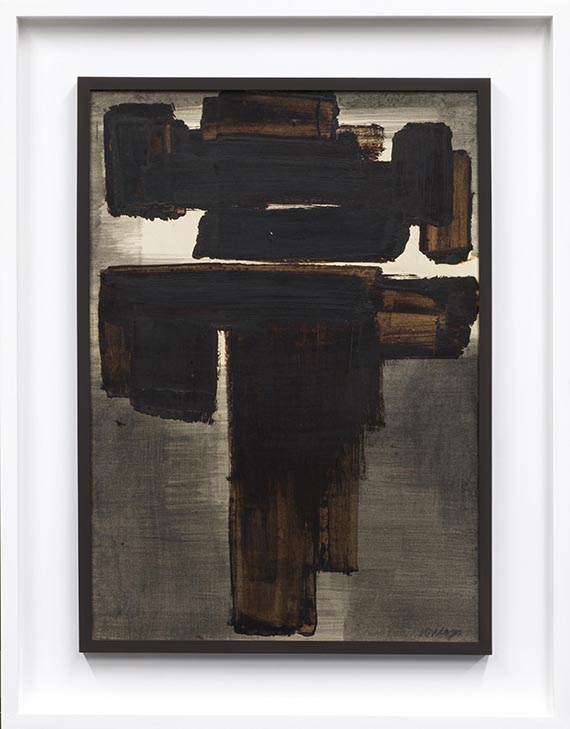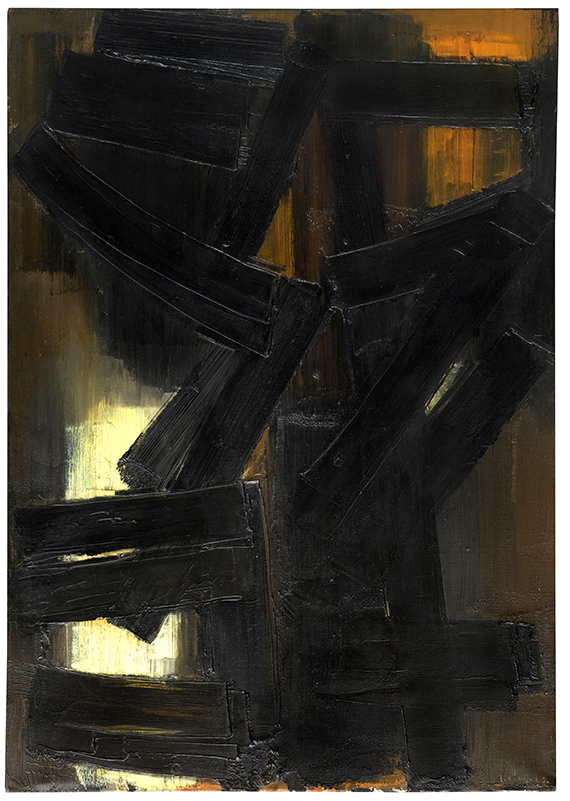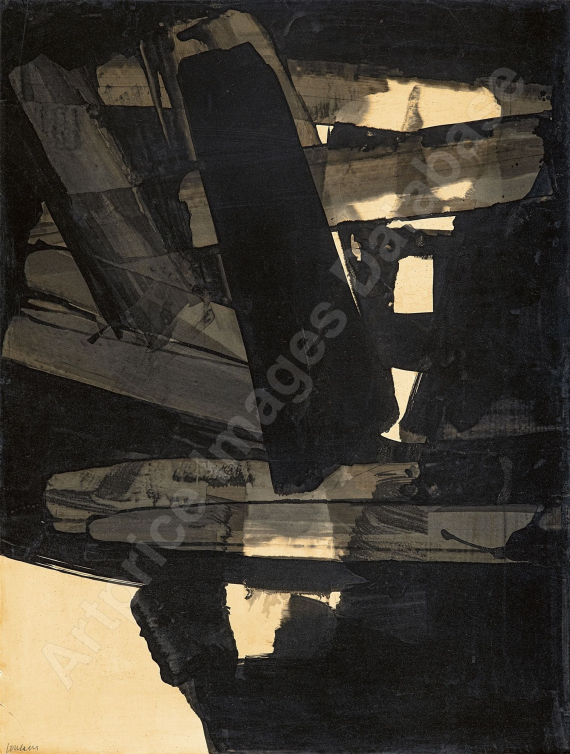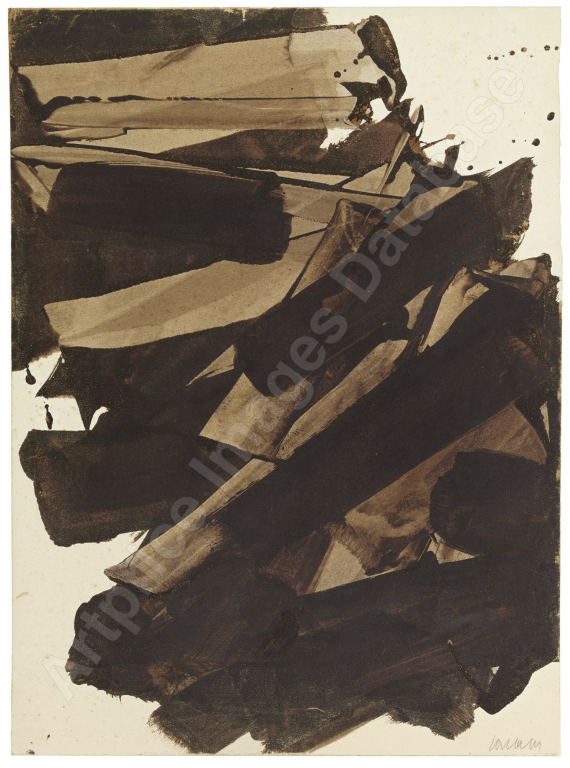66
Pierre Soulages
Brou de noix et encre sur papier 66 x 46,5 cm, 1956, 1956.
Mixed media on paper, laid on canvas
Estimate:
€ 180,000 - 240,000
$ 192,600 - 256,800
Brou de noix et encre sur papier 66 x 46,5 cm, 1956. 1956.
Mixed media on paper, laid on canvas.
Signed in lower right. 66 x 46.5 cm (25.9 x 18.3 in).
• Powerful composition from the groundbreaking early creative years when Soulages found his unmistakable gestural style.
• The artist participated in documenta I, II and III in 1955, 1959 and 1964.
• Compositions from the 1950s are in the most important international collections like the Solomon R. Guggenheim Museum, New York, the National Gallery of Art, Washington, D.C., the Tate in London, the Centre Pompidou, Paris, and the Folkwang Museum, Essen.
Accompanied by a photo certificate issued by Colette Soulages on April 8, 2024.
PROVENANCE: Dr. Hanns Hülsberg Collection, Hagen.
Ever since family-owned.
EXHIBITION: Pierre Soulage. Gouaches et Gravures, Galerie Berggruen & Cie., Paris 1957, p. 12 with color illu.
Pierre Soulages (http://musee-soulages-rodez.fr)
Called up: June 7, 2024 - ca. 19.10 h +/- 20 min.
Mixed media on paper, laid on canvas.
Signed in lower right. 66 x 46.5 cm (25.9 x 18.3 in).
• Powerful composition from the groundbreaking early creative years when Soulages found his unmistakable gestural style.
• The artist participated in documenta I, II and III in 1955, 1959 and 1964.
• Compositions from the 1950s are in the most important international collections like the Solomon R. Guggenheim Museum, New York, the National Gallery of Art, Washington, D.C., the Tate in London, the Centre Pompidou, Paris, and the Folkwang Museum, Essen.
Accompanied by a photo certificate issued by Colette Soulages on April 8, 2024.
PROVENANCE: Dr. Hanns Hülsberg Collection, Hagen.
Ever since family-owned.
EXHIBITION: Pierre Soulage. Gouaches et Gravures, Galerie Berggruen & Cie., Paris 1957, p. 12 with color illu.
Pierre Soulages (http://musee-soulages-rodez.fr)
Called up: June 7, 2024 - ca. 19.10 h +/- 20 min.
A group of European avant-garde artists in post-war Europe, among them Pierre Soulages, as well as several like-minded painters in New York discovered the non-color black as a means of expression. From a European perspective, they cleansed the colorful and naturalistic paths of the recent artistic past and reflected on the dark black origin of our existence. “Black,” according to the English author and art critic David Sylvester, “was a sacred color for the Abstract Expressionists, it was their lapis lazuli; they charged it with a mystical aura, partly perhaps because of its austerity, partly perhaps because there was something magnificent macho about creating a proper strong black." (David Sylvester, quoted from: Ex. cat. Black Paintings, Haus der Kunst Munich, Ostfildern 2006, p. 11)
Pierre Soulages was one of France's most important abstract expressionists.
His quest for non-figurative art led him to gestural-intuitive painting in the 1950s. Even in early works from the late 1950s, Pierre Soulages found his central motif - the relationship between color and surface. He did not want to depict anything but to create autonomous works grounded in their nature. Without just obscuring, the color black played a decisive role in this process. His use of black is thicker in some and more lucid in other places, thus he explored light and darkness in his painting. In doing so, he succeeded in ensuring that the dark color does not absorb the light but becomes a source of luminosity.
As of the mid-1950s, it was no longer just symbolic structures that brought life to the canvas, instead, he created a two-dimensional and at the same time deep, richly structured composition with the most minimal of means. Pierre Soulages did not need more than a few subtly nuanced shades for this purpose. He applied the brown with a broad brush over diaphanous layers of black that condensed into massive blocks in front of translucent fields.
This type of brown is a Soulages specialty. Applying the paint to the image carrier with a variety of brushes and palette knives, he uses “brou de noix”, a mordant made from the green shell of walnuts and mainly used in woodworking, for his paintings. He described the special nature of the material as follows: “I use brou de noix for its painterly qualities: the relationship between fluidity and viscosity, between transparency and opacity, and also for the contour quality of the applied color: clear, lumpy, blurred.” (transl. quote from http://musee-soulages-rodez.fr)
In the present work, the playful application of paint culminates in the juxtaposition of a blank background and the brownish nuances laid above it. In keeping with the artist's abovementioned characterization, these nuances condense into impenetrable matter. This is accompanied by the rich diaphanous veil of black. The result is a dynamic stage for a composition both structured and yet so sophisticated. [EH]
Pierre Soulages was one of France's most important abstract expressionists.
His quest for non-figurative art led him to gestural-intuitive painting in the 1950s. Even in early works from the late 1950s, Pierre Soulages found his central motif - the relationship between color and surface. He did not want to depict anything but to create autonomous works grounded in their nature. Without just obscuring, the color black played a decisive role in this process. His use of black is thicker in some and more lucid in other places, thus he explored light and darkness in his painting. In doing so, he succeeded in ensuring that the dark color does not absorb the light but becomes a source of luminosity.
As of the mid-1950s, it was no longer just symbolic structures that brought life to the canvas, instead, he created a two-dimensional and at the same time deep, richly structured composition with the most minimal of means. Pierre Soulages did not need more than a few subtly nuanced shades for this purpose. He applied the brown with a broad brush over diaphanous layers of black that condensed into massive blocks in front of translucent fields.
This type of brown is a Soulages specialty. Applying the paint to the image carrier with a variety of brushes and palette knives, he uses “brou de noix”, a mordant made from the green shell of walnuts and mainly used in woodworking, for his paintings. He described the special nature of the material as follows: “I use brou de noix for its painterly qualities: the relationship between fluidity and viscosity, between transparency and opacity, and also for the contour quality of the applied color: clear, lumpy, blurred.” (transl. quote from http://musee-soulages-rodez.fr)
In the present work, the playful application of paint culminates in the juxtaposition of a blank background and the brownish nuances laid above it. In keeping with the artist's abovementioned characterization, these nuances condense into impenetrable matter. This is accompanied by the rich diaphanous veil of black. The result is a dynamic stage for a composition both structured and yet so sophisticated. [EH]
66
Pierre Soulages
Brou de noix et encre sur papier 66 x 46,5 cm, 1956, 1956.
Mixed media on paper, laid on canvas
Estimate:
€ 180,000 - 240,000
$ 192,600 - 256,800
Buyer's premium, taxation and resale right compensation for Pierre Soulages "Brou de noix et encre sur papier 66 x 46,5 cm, 1956"
This lot can be purchased subject to differential or regular taxation, artist‘s resale right compensation is due.
Differential taxation:
Hammer price up to 800,000 €: herefrom 32 % premium.
The share of the hammer price exceeding 800,000 € is subject to a premium of 27 % and is added to the premium of the share of the hammer price up to 800,000 €.
The share of the hammer price exceeding 4,000,000 € is subject to a premium of 22 % and is added to the premium of the share of the hammer price up to 4,000,000 €.
The buyer's premium contains VAT, however, it is not shown.
Regular taxation:
Hammer price up to 800,000 €: herefrom 27 % premium.
The share of the hammer price exceeding 800,000 € is subject to a premium of 21% and is added to the premium of the share of the hammer price up to 800,000 €.
The share of the hammer price exceeding 4,000,000 € is subject to a premium of 15% and is added to the premium of the share of the hammer price up to 4,000,000 €.
The statutory VAT of currently 19 % is levied to the sum of hammer price and premium. As an exception, the reduced VAT of 7 % is added for printed books.
We kindly ask you to notify us before invoicing if you wish to be subject to regular taxation.
Calculation of artist‘s resale right compensation:
For works by living artists, or by artists who died less than 70 years ago, a artist‘s resale right compensation is levied in accordance with Section 26 UrhG:
4 % of hammer price from 400.00 euros up to 50,000 euros,
another 3 % of the hammer price from 50,000.01 to 200,000 euros,
another 1 % for the part of the sales proceeds from 200,000.01 to 350,000 euros,
another 0.5 % for the part of the sale proceeds from 350,000.01 to 500,000 euros and
another 0.25 % of the hammer price over 500,000 euros.
The maximum total of the resale right fee is EUR 12,500.
The artist‘s resale right compensation is VAT-exempt.
Differential taxation:
Hammer price up to 800,000 €: herefrom 32 % premium.
The share of the hammer price exceeding 800,000 € is subject to a premium of 27 % and is added to the premium of the share of the hammer price up to 800,000 €.
The share of the hammer price exceeding 4,000,000 € is subject to a premium of 22 % and is added to the premium of the share of the hammer price up to 4,000,000 €.
The buyer's premium contains VAT, however, it is not shown.
Regular taxation:
Hammer price up to 800,000 €: herefrom 27 % premium.
The share of the hammer price exceeding 800,000 € is subject to a premium of 21% and is added to the premium of the share of the hammer price up to 800,000 €.
The share of the hammer price exceeding 4,000,000 € is subject to a premium of 15% and is added to the premium of the share of the hammer price up to 4,000,000 €.
The statutory VAT of currently 19 % is levied to the sum of hammer price and premium. As an exception, the reduced VAT of 7 % is added for printed books.
We kindly ask you to notify us before invoicing if you wish to be subject to regular taxation.
Calculation of artist‘s resale right compensation:
For works by living artists, or by artists who died less than 70 years ago, a artist‘s resale right compensation is levied in accordance with Section 26 UrhG:
4 % of hammer price from 400.00 euros up to 50,000 euros,
another 3 % of the hammer price from 50,000.01 to 200,000 euros,
another 1 % for the part of the sales proceeds from 200,000.01 to 350,000 euros,
another 0.5 % for the part of the sale proceeds from 350,000.01 to 500,000 euros and
another 0.25 % of the hammer price over 500,000 euros.
The maximum total of the resale right fee is EUR 12,500.
The artist‘s resale right compensation is VAT-exempt.




 Lot 66
Lot 66 




